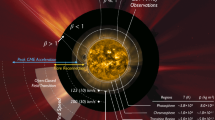Abstract
In the mean, bipolar active regions are oriented nearly toroidally, according to Hale's polarity law, with a latitude-dependent tilt known as Joy's Law. The tilt angles of individual active regions deviate from this mean behavior and change over time. It has been found that on average the change is toward the mean angle at a rate characteristic of 4.37 days (Howard, 1996). We show that this orientational relaxation is consistent with the standard model of flux tube emergence from a deep dynamo layer. Under this scenario Joy's law results from the Coriolis effect on the rising flux tube (D'Silva and Choudhuri, 1993), and departures from it result from turbulent buffeting of the tubes (Longcope and Fisher, 1996). We show that relaxation toward Joy's angle occurs because the turbulent perturbations relax on shorter time scales than the perturbations from the Coriolis force. The turbulent perturbations relax more rapidly because they are localized to the topmost portion of the convection zone while the Coriolis perturbations are more widely distributed. If a fully-developed active region remains connected to the strong toroidal magnetic field at the base of the convection zone, its tilt will eventually disappear, leaving it aligned perfectly toroidally. On the other hand, if the flux becomes disconnected from the toroidal field the bipole will assume a tilt indicative of the location of disconnection. We compare models which are connected and disconnected from the toroidal field. Only those disconnected at points very deep in the convection zone are consistent with observed time scale of orientational relaxation.
Similar content being viewed by others
References
Achterberg, A.: 1996, Astron. Astrophys. 313, 1008.
Caligari, P., Moreno-Insertis, F., and Schüssler, M.: 1995, Astrophys. J. 441, 886.
Choudhuri, A. R.: 1989, Solar Phys. 123, 217.
Choudhuri, A. R. and Dikpati, M.: 1999, Solar Phys. 184, 61
Choudhuri, A. R. and Gilman, P. A.: 1987, Astrophys. J. 316, 788.
Choudhuri, A. R., Schüssler, M., and Dikpati, M.: 1995, Astron. Astrophys. 303, L29.
Dikpati, M. and Charbonneau, P.: 1999, Astrophys. J. 518, 508.
D'Silva, S. and Choudhuri, A. R.: 1993, Astron. Astrophys. 272, 621.
D'Silva, S. and Howard, R. F.: 1993, Solar Phys. 148, 1.
Durney, B. R.: 1995, Solar Phys. 160, 213.
Durney, B. R.: 1997, Astrophys. J. 486, 1065.
Fan, Y., Fisher, G. H., and DeLuca, E. E.: 1993, Astrophys. J. 405, 390.
Fan, Y., Fisher, G. H., and McClymont, A. N.: 1994, Astrophys. J. 436, 907.
Hale, G. E., Ellerman, F., Nicholson, S. B., and Joy, A. H: 1919, Astrophys. J. 49, 153.
Howard, R. F.: 1992, Solar Phys. 137, 205.
Howard, R. F.: 1996, Solar Phys. 169, 293.
Howard, R. F., Gilman, P. A., and Gilman, P. I.: 1984. Astrophys. J. 283, 373.
Longcope, D. W. and Fisher, G. H.: 1996, Astrophys. J. 458, 380.
Lundquist, L. L. and Fisher, G. H.: 2001, AGU, Sping Meeting 2001.
Moreno-Insertis, F., Schuessler, M., and Ferriz-Mas, A.: 1996, Astron. Astrophys. 312, 317.
Nandy, D. and Choudhuri, A. R.: 2001, Astrophys. J. 551, 576.
Press, W. H., Flannery, B. P., Teukolsky, S. A., and Vetterling, W. T.: 1986, Numerical Recipes: The Art of Scientific Computing, Cambridge University Press, Cambridge.
Ryutov, D. A. and Ryutova, M. P.: 1976, Soviet Phys. JETP 43, 491.
Spruit, H. C.: 1974, Solar Phys. 34, 277.
Spruit, H. C.: 1981, Astron. Astrophys. 98, 155.
Spruit, H. C., Title, A. M., and van Ballegooijen, A. A.: 1987, Solar Phys. 110, 115.
Wang, Y.-M. and Sheeley, N. R.: 1989, Solar Phys. 124, 81.
Wang, Y.-M., Nash, A. G., and Sheeley, N. R.: 1989, Astrophys. J. 347, 529.
Author information
Authors and Affiliations
Rights and permissions
About this article
Cite this article
Longcope, D., Choudhuri, A.R. The Orientational Relaxation of Bipolar Active Regions. Solar Physics 205, 63–92 (2002). https://doi.org/10.1023/A:1013896013842
Issue Date:
DOI: https://doi.org/10.1023/A:1013896013842




